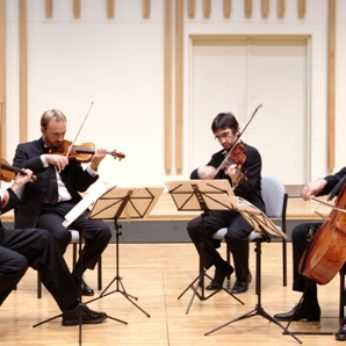Composer: Ahmed Adnan Saygun (b. 1907 - d. 1991)
Performance date: 01/07/2013
Venue: St. Brendan’s Church
Composition Year: 1958
Duration: 00:29:41
Recording Engineer: Damian Chennells, RTÉ lyric fm
Instrumentation: 2vn, va, vc
Instrumentation Category:String Quartet
Artists:
Quatuor Danel (Marc Danel, Gilles Millet [violins], Vlad Bogdanas [viola], Guy Danel [cello]) -
[quartet]

Saygun was born in
the waning years of the Ottoman Empire and came of age just as the new
many national composers of that era he was an avid researcher of his country’s
traditional folk music and he even took Bartók himself on a research tour in
symphonies, five concertos, four string quartets, an oratorio on the Sufi
mystic Yunus Emre and many other works. Although Saygun’s quartets are steeped
in the European heritage, his inclusion of ideas derived from Turkish folk
music ensure his quartets stand out unmistakably when heard alongside other
European works.
His Second Quartet,
like Bartók’s Fifth, was yet another commission by the Elizabeth Sprague
Coolidge Foundation and was premiered by the Juillard Quartet in
some idea of Saygun’s international reach in his lifetime. The first movement
opens with a dreamlike theme on the viola with hints of Russian introspection.
This is in acute contrast with an intensely dramatic main theme out of which
another idea develops much in the manner of Bartók leading eventually to a
hard-hitting climax, which returns us to the beginning with the theme in the
violin this time. At the close the viola reclaims his sad song.
If the nationality of
the composer was in doubt in the opening movement, the extraordinary second
movement is clearly of oriental origin. It begins with a col legno ostinato
tapping from the cello in a sinister rhythm that hints at drama to follow, which
a high-lying violin quickly supplies. Each return of the ostinato rhythm leads to
new, mostly violent, ideas. The invention never seems to falter as each time
the music takes breath, a new storm is unleashed. The morendo ending is a surprise but signals that the drama is not yet
concluded. And the third movement does not disappoint with a wild Turkish dance
whose momentum is driven by a combination of pizzicato and bowing in dizzying
combinations. The thrilling finale juxtaposes grave and animato scenes
in extreme alterations built up with Saygun’s innate dramatic flair.
Copyright © 2024 West Cork Music. All rights reserved.
Designed and developed by Matrix Internet